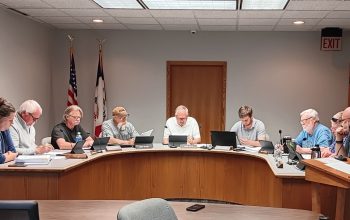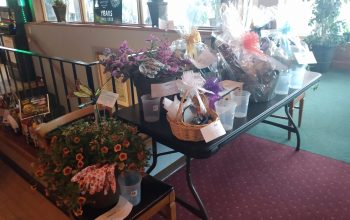Quinn Whaley started showing cattle in the fourth grade after his sister, Shea, got an offer from Denny Johnson to show a heifer. Once she started, Quinn wanted in too, so he showed a heifer calf named Snickers at the Clay County Fair Open Prospect show. But once the Whaley’s moved to an acreage south of Eagle Grove in 2014, the kids got more and more involved with showing cattle, and even started traveling to compete at out-of-state competitions. Quinn’s first competition with cattle was in 2015. Both he and Shea have both done incredibly well over the years, but after last week, Quinn has one more major award under his belt. He and his steer, Jett, just won the Grand Champion Bred and Owned Prospect Steer title at the National Junior Heifer Show Maine Anjou in Chickasha, Oklahoma.
With the relationship that formed between Quinn and Jett (named because he was so “Jet Black” in color, but Quinn’s five-year-old cousin, Jetta, thinks they named him after her…it’s become kind of a joke), it’s no surprise they brought home the top trophy. Their beginning was a little different than most. Quinn wanted a fall-born heifer, so they planned accordingly. He even picked out the exact bull he would breed with his heifer. Everything was perfect, and when it was time for the calf to be born in September of 2020, Quinn was there. That’s when they discovered the heifer he had hoped for instead turned out to be a bull calf that they would later turn into a steer (a male that is castrated before they develop physical characteristics of a bull). But first things first. When Jett was born, Quinn and his dad, Bryan, noticed that only two teats of the cow’s four were releasing milk properly. To get them working so it wouldn’t compromise the ability of all four quarters of her udder to produce milk and adequately feed a calf, Quinn and his family put the mom in a chute while the baby nursed, using all four teats, but especially the two that were more difficult. It worked. But what also happened during that time was that Jett got used to being around people right away.
“We were around (Jett) a lot, so he got really friendly with us,” explained Quinn.
“That made him super chill with people,” added Quinn’s mom, Allison, with her son shaking his head in agreement.
Most calves at that age are just out roaming free in the pasture…which Jett eventually got to go and experience once the nursing issue was worked out.
In January, 2021, they brought Jett back in from the pasture in order to wean him. In February, Shea began halter breaking the steer for her brother. After Jett was broke, Quinn began washing him once a week, just to get him used to the process (the first time took 2.5 hours). At the beginning of April, they started washing Jett three times a week in preparation for his first show, the Minnesota Junior Spring Classic, which took place in Austin. Jett won Reserve Champion Prospect Steer at that show.
“That was (Jett’s) first trip off the farm,” commented Allison.
After that show he got rinsed almost every day. About a month ago, Quinn brought him inside and began working Jett’s hair. A quality hair coat can really enhance the positive qualities of a calf. You’ve got to keep it clean in order for it to grow, and summer is not the typical time of year for good hair growth for a steer because of the heat and daylight. To combat these factors, Quinn kept Jett in a barn so he was out of the daylight. He also kept him under fans, and rinsed him regularly to keep his hide cool – all promoting hair growth. Another key to hair success for his steer was “working the hair.” Quinn explained this process saying that on the days Jett doesn’t get washed, he gets rinsed. They blow the water out and then use products before brushing his hair. Quinn brushes it hard and forward towards the head, in efforts to train it.
“A lot of it is genetics, but (Jett) has very thick, wooly, curly hair,” explained Allison. “The training of the hair is very important to get it to go all the same direction.”
“Forward at a 45 degree angle,” added Quinn.
At first Jett wasn’t too crazy about this process, but he’s gotten used to what you could call this “steer beauty shop.”
“He just stands there now,” Quinn said with a little chuckle.
There are many cattle shows to travel to every year, but the Whaleys decide where and when they go according to what type of cattle they have to compete in the classes, distance, weather, work schedules, and more. In 2021, they’ve already competed at seven different shows. Their future calendar for this year also includes the Wright County Fair, the Hamilton County Fair, and the Iowa State Fair, and maybe the National Livestock Expedition in Louisville, Kentucky in November.
“That’s been one he’s always wanted to do,” said Allison. “We just need to have the caliber of stock to take there, so we will see.”
Quinn's favorite part of competing is “fitting” the animal, although he admitted it can be stressful sometimes. This is the process of getting the animal ready before a show…grooming and clipping to get them to look a specific way.
“I would liken it to a hair stylist, going to get a special do,” joked Allison.
It’s important because a well-fitted steer leg can make the animal’s bones and joints look more impressive. For Quinn, part of this process includes clipping their hair, using a special glue to shape the hair, white paint to build the leg, clip it, more shaping… until he achieves the look he is wanting.
In a show, judges aren’t necessarily looking for a specific fitting, but instead the fitting enhances things like bone, muscle…is it going to yield a lot of meat in the freezer when all is said and done.
“You need good, sound structure so that the animal can make it to 1350 pounds and be profitable,” Allison added.
In addition to showing the animal, there are sometimes other activities the kids can participate in. At the National Junior Heifer show they just competed at last week, for example, Quinn participated with a team in a Quiz Bowl where they won 2nd Place in the intermediate division (there were 30+ teams), participated in a team fitting event, and appeared in the showmanship semifinals with “Phyllis,” a Maine Angus. He also had fun playing in a kickball tournament there. He also participated in the speech and salesmanship competition online before the show.
Shea was also busy in Oklahoma, serving as the At-Large Director for the Junior Chianina Board, entering a photography competition (she got 4th Place) and was awarded a $750 scholarship from the Chianina Ladies Auxiliary.
Quinn loves showing cattle, despite the fact that he has been stepped on, kicked, drug, and even has a scar from it. It will take more than that to stop him from doing what he loves. He is grateful that his parents encourage and support his hobby.







